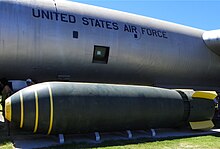Mark 17 nuclear bomb
This article needs additional citations for verification. (July 2007) |

The Mark 17 and Mark 24 were the first mass-produced hydrogen bombs deployed by the United States. The two differed in their "primary" stages. They entered service in 1954, and were phased out by 1957.
Design and development
Design and development originated when Los Alamos National Laboratory proposed that a bomb design using lithium deuteride with non-enriched lithium was possible. The new design was designated TX-17 on February 24, 1953. The TX-17 and 24 were tested as the "Runt" (Castle Romeo shot) device during Operation Castle in 1954.[1] After the successful tests, basic versions of the Mk 17 and 24 were deployed as part of the "Emergency Capability" program.
The MK 17/24 bombs were 24 feet 8 inches (7.52 m) long, 61.4 inches (1.56 m) diameter. They weighed 21 tons. The Mark 17 had a yield of 15 megatonnes of TNT (63 PJ).[2] Total production of Mk 17s was 200, and there were 105 Mk 24s produced, all between October 1954 and November 1955. The Mark 17 and Mark 24 were identical in all respects save for the design of their primary section.[2] They were the largest nuclear weapons ever put into service by the United States; only the Convair B-36 Peacemaker was capable of carrying them.[3]
Operational history

A total of five EC 17 and ten EC 24 bombs subsequently entered stockpile and were added between April and October 1954. The EC weapons were quickly replaced with Mk 17 Mod 0 and Mk 24 Mod 0 bombs in October and November 1954. Those weapons included a 64-foot-diameter (20 m) parachute to allow the delivery aircraft to escape. With the addition of in-flight insertion of the Primary capsule to prevent a nuclear explosion in case of an accident, the weapons were upgraded to the Mod 1 standard. The inclusion of a contact fuze upgraded some bombs to the Mod 2 version, allowing the bombs to be used against "soft" targets (air burst), or buried targets such as command bunkers (contact burst).
Due to the introduction of smaller and lighter weapons such as the Mk 15, as well as the pending retirement of the only aircraft capable of carrying them, the B-36, the Mk 24s were withdrawn by October 1956, with the Mk 17s withdrawn by August 1957.
1957 incident

On May 27, 1957 a Mark 17 was unintentionally jettisoned from a B-36 just south of Albuquerque, New Mexico's Kirtland AFB. The device fell through the closed bomb bay doors of the bomber, which was approaching Kirtland at an altitude of 520 metres (1,700 ft). The device's conventional explosives destroyed it on impact, leaving a crater 7.6 metres (25 ft) in diameter and 3.7 metres (12 ft) deep.[4] Though a chain reaction was impossible because the plutonium pits were stored separately on the plane as a safety measure, the incident spread radioactive contamination and debris over a mile-wide area. The military thoroughly cleaned up and decontaminated the site although a few fragments of the bomb - some still radioactive - are occasionally found in the area. A marker was placed on the site in 1996 by the Center for Land Use Interpretation, however it was subsequently removed.[5]
Survivors
Five MK 17/24 casings are on display to the public:
- National Museum of Nuclear Science & History located at Albuquerque, New Mexico.
- The Strategic Air Command Memorial at Naval Air Station Fort Worth Joint Reserve Base at Carswell Field in Fort Worth, Texas.
- The National Museum of the United States Air Force in Dayton, Ohio has a Mk 17/24 casing on display in its Cold War Hangar.
- The Strategic Air and Space Museum in Ashland, Nebraska.
- Castle Air Museum, Atwater, Ca
See also
References
Citations
Bibliography
- Ausherman, Stephen (2015). Walking Albuquerque. Birmingham, Alabama: Wilderness Press. ISBN 978-0-89997-767-6.
- Cochran, Thomas; William Arkin; Milton Hoenig (1984). Nuclear Weapons Databook, Volume I, U.S. Nuclear Forces and Capabilities. Cambridge, Massachusetts: Ballinger. ISBN 0-88410-173-8..
- Hansen, Chuck (1988). U.S. Nuclear Weapons: The Secret History. Arlington, Texas: Aerofax. ISBN 0-517-56740-7..
- Gibson, James N. (1996). Nuclear Weapons of the United States. Altglen, Pennsylvania: Schiffer Publishing. ISBN 0-7643-0063-6..
- Parsons, Keith M.; Robert A. Zaballa (2017). Bombing the Marshall Islands: A Cold War Tragedy. Cambridge, UK: Cambridge University Press. ISBN 978-1-107-04732-7.
- Rhodes, Richard (1995). Dark Sun: The Making of the Hydrogen Bomb. New York: Simon & Schuster. ISBN 978-0-684-80400-2.
